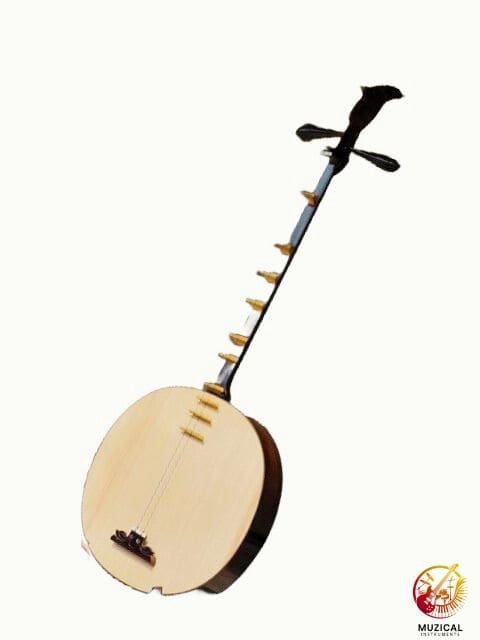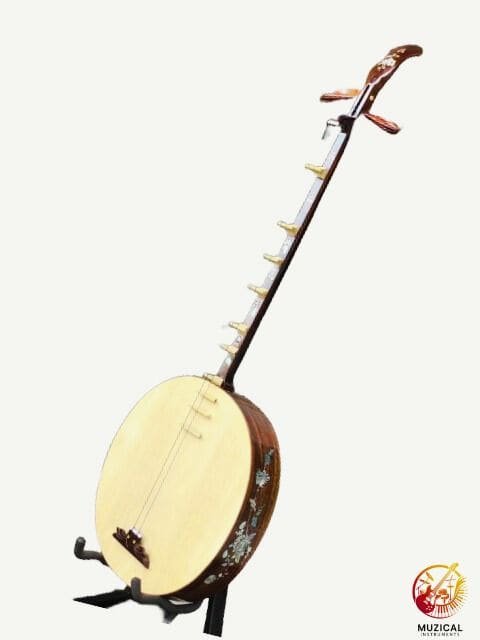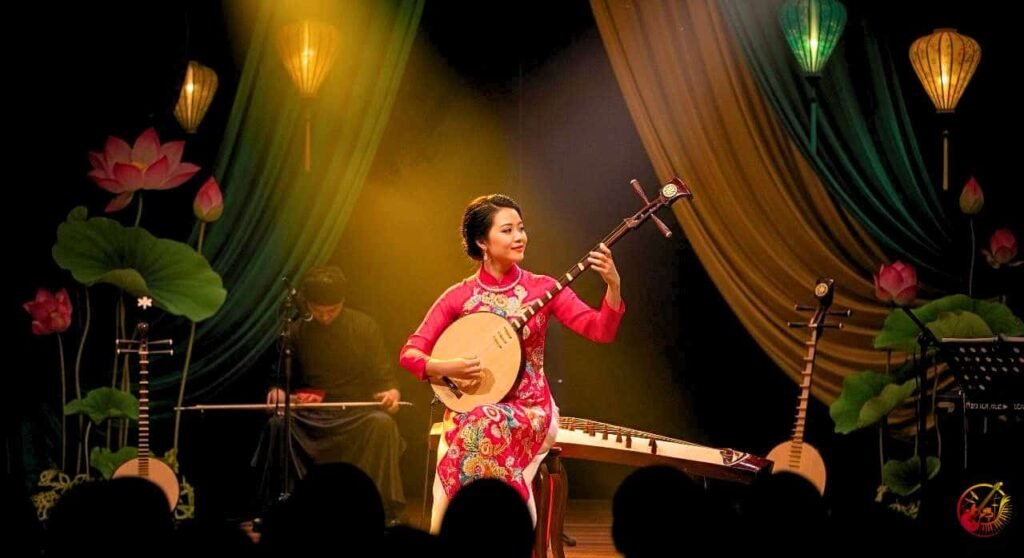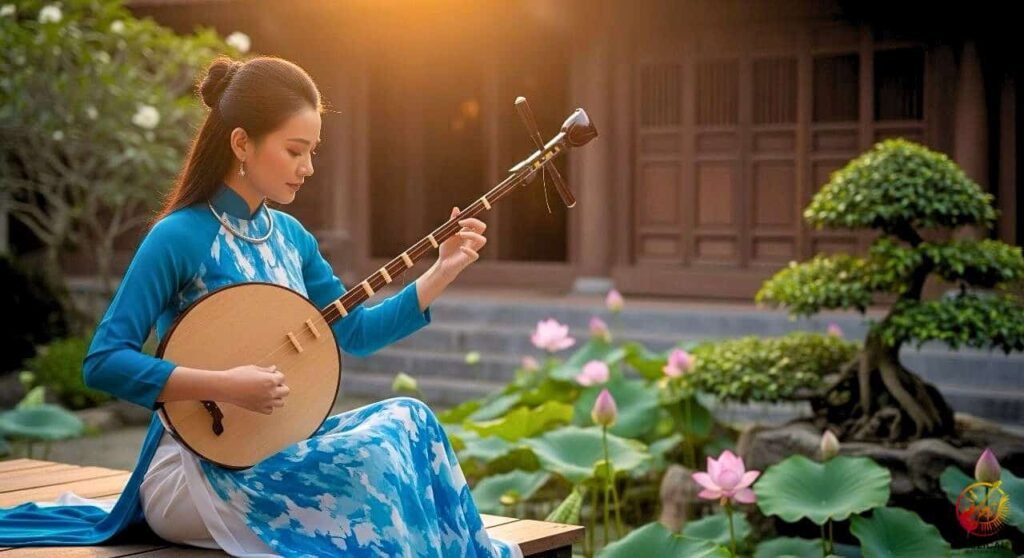What Is Dan Nguyet? The Moon Shaped Heart of Vietnamese Music
What is dan nguyet? It is one of Vietnam’s most iconic traditional instruments. The dan nguyet, often called the “moon lute,”. Its name translates directly to “moon instrument,” and once you see its round, glowing body, you’ll understand why.
But this isn’t just a pretty name. The dan nguyet holds centuries of history, emotion, and cultural expression in its wooden frame. It’s used in everything from royal court music to modern fusion genres. And it’s growing, adapting, and even showing up on global stages.
Here you’ll learn exactly what the dan nguyet is, how it works, where it comes from, and how it continues to thrive in today’s world.
We’ll also explore its construction, cultural use, tuning system, and compare it to other similar Asian lutes. You’ll leave with a full picture and maybe even an itch to hear or play it yourself.
What is Dan Nguyet? Exploring Its Unique Look and Construction
If you find yourself asking, “What is dan nguyet?“, its appearance offers the first clue. The instrument has a very distinct look: a long wooden neck and a round, flat soundbox shaped like the full moon. The round body helps create its bright, sweet, and clear tone.


Most dan nguyet instruments are made of hardwood like jackfruit or rosewood. These are chosen not only for their durability but also for their sound quality. The face of the body is usually softwood, like paulownia, which vibrates well and adds warmth to the sound.
Here’s how its parts come together:
| Part | Material | Purpose |
|---|---|---|
| Body (soundbox) | Hardwood frame + softwood face | Resonates the sound, creates tone |
| Neck | Hardwood, often with bone or shell inlay | Holds tuning pegs, allows playing technique |
| Strings | Originally silk, now nylon or steel | Produces sound through vibration |
| Frets | Raised metal or bamboo | Creates pitch and supports bending techniques |
Unlike Western lutes or guitars, the frets on the dan nguyet are high and widely spaced. This allows players to bend notes smoothly, a key feature of Vietnamese music.
Expert Insight: Luthiers in Vietnam still build dan nguyet by hand, often using ancestral techniques passed down over generations. Each instrument is slightly unique in tone and feel, like a fingerprint.
How Is Dan Nguyet Played, and What Does It Sound Like?
When exploring what is dan nguyet, its sound and playing style are just as important as its appearance. The instrument has two strings and is played either by fingers or with a small plectrum (pick). It produces a sharp, bell-like tone that’s both clear and expressive. It cuts through an ensemble while still sounding lyrical and delicate.

Here’s what sets it apart:
- Tonal Range: Mid to high register; similar to a soprano vocal range.
- Play Techniques: Slides, bends, fast trills, and staccato plucks.
- Common Tunings:
- G–D (Western fifth)
- A–E (Vietnamese modal tuning)
- Or other tunings based on the vocal register of the singer
Want to hear it? Listen to a solo dan nguyet piece from Vietnam’s ca trù tradition, it’s haunting, hypnotic, and deeply emotional.
The dan nguyet is often used to mimic the human voice. That’s why you’ll hear so much vibrato and note bending. The music isn’t meant to be perfect, it’s meant to feel alive.
What Are the Roots of Dan Nguyet in Vietnamese History?
To truly answer the question, “What is dan nguyet?“, we must look at its deep roots in Vietnamese history. The instrument has been around for centuries, but tracing its exact origin is tricky. Some scholars believe it evolved from Chinese instruments like the yueqin or qin pipa, but the Vietnamese version developed its own design, tuning, and playing style.
It became popular during the Lê dynasty (15th–18th century) and was widely used in:
- Court music: Played in palaces and ceremonies
- Folk music: Especially in northern Vietnam
- Religious settings: Used in Buddhist chanting and temple rituals
Unlike many other traditional instruments, the dan nguyet was never tied to a single class or group. It was used by royalty, monks, farmers, and scholars alike. That’s part of why it stayed relevant across time.
Pro Tip: If you’re studying Vietnamese history, notice how the dan nguyet shows up in old paintings, poems, and even folk tales. It’s not just an instrument, it’s a symbol of beauty and refinement.
Where Do You Hear Dan Nguyet Today?
You might think an old, two-string lute would vanish in a world of electric guitars and digital beats but not this one.
Today, you’ll find the dan nguyet in:
- Vietnamese opera (like chèo and cải lương)
- Folk ensembles across northern and central Vietnam
- Vietnamese traditional orchestras
- Modern fusion bands, blending East and West
- Vietnamese diaspora communities in the U.S., Canada, and France
It’s also taught in conservatories and music schools in Hanoi and Ho Chi Minh City.
| Setting | Role of Dan Nguyet |
|---|---|
| Traditional theater | Melodic support and dramatic accenting |
| Wedding or temple ceremonies | Leads vocal chanting |
| Modern pop/jazz fusion | Adds Vietnamese color and texture |
| Academic study | Example of Southeast Asian lute evolution |
In 2019, a dan nguyet solo performance was even featured at the Vietnamese Cultural Festival in Paris, showcasing its global appeal.
What Makes the Dan Nguyet Unique Among Asian Lutes?
Asia is rich with stringed instruments, especially lutes. But the dan nguyet stands out in both look and sound.
Let’s compare:
| Instrument | Country | Body Shape | Number of Strings | Playing Style |
|---|---|---|---|---|
| Đàn nguyệt | Vietnam | Round/moon-like | 2 | Bending, plucking |
| Yueqin | China | Round | 2–4 | Percussive, light bends |
| Biwa | Japan | Pear-shaped | 4–5 | Strummed with large pick |
| Pipa | China | Pear-shaped | 4 | Fast finger rolls, arpeggios |
| Đàn tranh | Vietnam | Long zither | 16+ | Plucked with picks |
The dan nguyet’s frets are especially high compared to most others. This gives it a vocal-like sliding ability that few other lutes can match. That’s why it’s ideal for Vietnamese pentatonic scales and folk melodies.
Contrarian View: Some modern musicians say the dan nguyet is too “limited” compared to 12-string guitars or 21-string zithers. But that “limitation” is also its strength. It forces creativity and brings clarity to every note.
How Is the Dan Nguyet Tuned and Maintained?
The tuning of the dan nguyet varies depending on the style and region. But in general, it follows a perfect fifth interval between the two strings. This allows players to hit a wide range of melodic combinations while keeping finger movements minimal.
Common tunings include:
- G3–D4 (Western fifth)
- A3–E4 (Northern Vietnamese folk style)
- C3–G3 (Used for accompaniment in chanting)
It’s often tuned by ear, especially by folk musicians. In fact, many players adjust the tuning mid-performance to match a singer’s vocal range or a change in mood.
Maintenance Tips:
- Wipe down the neck and body after each session to prevent moisture damage
- Store in a soft case to protect the soundboard
- Change nylon or metal strings every 6–8 months, depending on use
- Avoid direct sun or high humidity, which can warp the wood
Expert Insight: If you’re switching from guitar or violin, you’ll notice how sensitive the dan nguyet is. Even a light touch changes the note. It rewards control and precision.
Is Dan Nguyet Hard to Learn?
The short answer? Yes and no.
If you’re already familiar with fretted instruments, you’ll pick up basic melodies fast. But mastering the dan nguyet is a long-term journey. Its expressiveness depends heavily on microtonal control, something not used in Western music.
Beginners will struggle with:
- Proper finger pressure on the high frets
- Accurate pitch bending
- Rhythmic plucking without a pick
However, the rewards are worth it. You’ll be able to imitate vocal inflection, layer mood into your playing, and create tones that few instruments can match.
Pro Tip: Many Vietnamese children begin learning on a student-grade dan nguyet, often passed down from relatives. There’s a sense of family tradition and pride that goes into it, something that motivates learning more than any app or course.
Why Does Dan Nguyet Still Matter Today?
In a fast-changing world, it’s easy for traditional instruments to get left behind. But the dan nguyet is not only surviving, it’s thriving.

Here’s why:
- Cultural identity: It represents Vietnamese pride and heritage.
- Adaptability: It blends with jazz, rock, EDM, and world music.
- Emotional depth: Its tone captures feelings better than many modern instruments.
- Education: It’s part of music curriculums and conservatory studies.
Many younger artists in Vietnam now use the dan nguyet in lo-fi beats, rap intros, or TikTok duets. It’s being sampled and remixed, not just preserved in a museum.
Thought-provoking question: Could the dan nguyet become Vietnam’s answer to the electric guitar, a traditional instrument that evolves with every generation?
Final Thoughts: Should You Explore Dan Nguyet?
Now you know what is dan nguyet. It’s not just a moon-shaped instrument, it’s a voice. A thread tying together history, culture, emotion, and sound.
No matter if you’re a musician, music lover, or cultural explorer, there’s something here for you. This isn’t an instrument of the past. It’s alive, present, and speaking clearly to the future.
Listen to live recordings, try a lesson if you can, or simply read more about Vietnam’s rich musical heritage. The more you understand, the more you’ll hear in every note.
Let this moon-shaped instrument light up your journey into music, one glowing tone at a time.
If you’re curious about other Vietnamese string instruments, the Vietnamese guitar with a scalloped fretboard offers a very different voice with deep cultural roots.
FAQ: What Is Dan Nguyet?
Q1. What does “Dan Nguyet” mean?
It means “moon lute” in Vietnamese. “Đàn” means instrument, and “Nguyệt” means moon. The name comes from the shape of its body, which is round like a full moon. It’s not just about looks, it also plays a bright, emotional tone that suits the name.
Q2. Can the Dan Nguyet play modern music?
Yes, it can. While the Dan Nguyet is built for traditional sounds, many young players now use it in pop, fusion, and jazz. With effects and amplifiers, some even play it in bands. It’s a mix of old soul and new sound.
Q3. Is the Dan Nguyet similar to any other instrument?
It’s a cousin to other Asian lutes like the Chinese yueqin and the Japanese shamisen, but the sound is unique. The Dan Nguyet has raised frets, a softer voice, and a different tuning system. It’s a key part of Vietnamese identity, not just another string instrument.
Q4. Is the Dan Nguyet hard to play?
It can be tricky at first. The two strings seem simple, but the frets are raised, which means you need good finger control. Players often slide, bend, and vibrate the notes to sound like singing. If you’re new to string instruments, it might take time. But once you get it, it feels natural and expressive.
Q5. What’s the best way to learn Dan Nguyet?
If you live near a Vietnamese cultural center, that’s a great place to start. You can also find video lessons online, some in English, many in Vietnamese. The key is to listen closely to the music and learn how the notes mimic human emotion. Start slow. The magic is in how you make each note sing.
